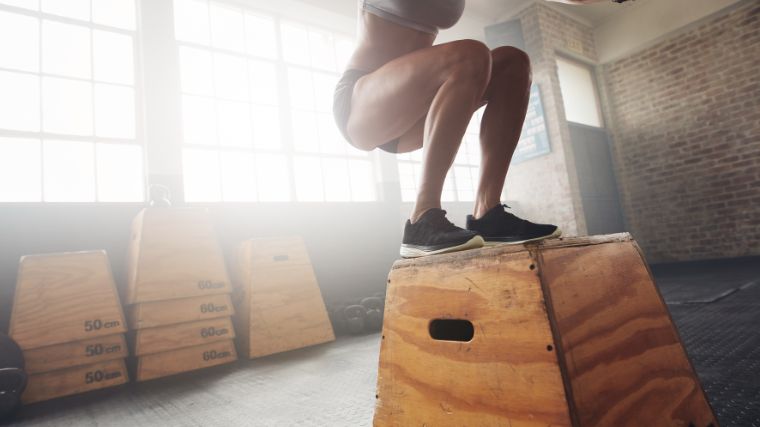Is Your Training Feeling Stale? It’s Time to Back Off and Re-Evaluate Your Approach
There are many roads to change, and "more" and "harder" are not the way to breathe new life into your goals. This approach is often a surefire way to shoot ourselves in the foot.
Suppose you’re considering changing up fundamentals like exercise routines, daily habits, nutrition, and mental and spiritual wellness. In that case, it may be valuable to look at your journey in terms of months, even a year, rather than 12 weeks or less. A longer-term approach allows us to build momentum and consistency more gradually and helps us yield the best and deepest experiences and outcomes for our training year.

Regardless of what time of year it is, if you’re feeling stagnant or overloaded and not seeing and feeling the results you want, take some to back off — it may be the best thing you ever do for your training.
Editor’s note: This article is an op-ed. The views expressed herein and in the video are the author’s and don’t necessarily reflect the views of BarBend. Claims, assertions, opinions, and quotes have been sourced exclusively by the author.
Back Off & Evaluate Where You’re At
You wouldn’t speed up if you’re cruising down the highway and see a pothole or traffic jam. Whatever your metaphorical "pothole" is, it’s better to take your foot off the gas, accept the situation you’re in, and take note of what you can (and can’t) control.
You can periodically and temporarily ease off the intensity (aka the gas) and re-evaluate your situation; we are not the same month to month and indeed not year to year. Honor that by hitting the brakes a little and looking at the landscape, especially if you’re noticing consistent burnout and high fatigue levels.
Here’s a practical example: The winter months are typically high-stress for many folks. Maybe you’re starting a new semester at school, or you’ve been swept up in the #NewYearNewYou madness and feel extra pressure to be your "best" ever. However, the holiday season is stressful — there’s travel, less-than-ideal food environments, and lots of socializing. Many people don’t sleep or feel their best during this time.
So what about six straight weeks of the hoopla mentioned above priming you to be your best self physically and mentally for an entire year? Probably not much. If that season puts you through a lot of wear and tear, use it as a time to lower intensity, and perform maintenance while shifting your training to work more holistically to improve and add to your life.
Regardless of what season it is, we all go through ups and downs, rough patches, and upswings, and this may be the best time to take a step back and re-evaluate your situation.

An excellent first step is an honest assessment of where you are right now. Any project of considerable worth or scope needs a planning phase and a cool-headed assessment of the current landscape. Make sure your first tools are copasetic with the terrain before.
If you’re kicking off a new program, are you selecting something you can add to your current schedule?
If you work eight hours a day, six days per week, why would you select a program requiring five two-hour sessions? That may be a workload and schedule you could work up to if you crave that level of intensity, but why not ramp up to that over time and start a program that’s logistically going to mesh with your current routine well and give your body a chance to catch up?
There are a lot of metrics in your life and training you can evaluate that may help you build momentum in terms of your sleep quality, nutrition, schedule, and current routine. While outside feedback from a coach or trusted training partner can be helpful, it’s not entirely necessary. Only you can decide where you need to go next, and if you’re willing to sit down and be honest with yourself, you’ll discover a lot. A trusted person/coach can be helpful — If you have a coach, utilize them, but don’t feel paralyzed in your evaluation process if you don’t have one.
Establish a Vision
Decide what you’re training for. Many folks reading this will be mid-program. Maybe an adjustment isn’t necessary, but it never hurts to look within and explore what your training is doing for you and what you should be doing for your training and your body to nurture and challenge its best short-term and long-term.
You may not have concrete training goals right now beyond "stay ready for heavy lifting, and stay healthy," and maybe you don’t need them. (Metric-based goals such as specific numbers seem more motivating for some people than others.) I’m personally motivated by feelings and a vision, but many folks are measurable-goal oriented. Some of us are both at different times.
Right now, I’m motivated by the whole picture: how I feel every day (training cannot create a net energy deficit), how I look and being what I call just "ready" strong: the ability to jump into a strongman competition at the first available opportunity and not destroy my body. I am very clear about what training does for me physically, mentally, and emotionally, and my clear perception of its role in my life dramatically informs the choices I make around it.
There are many reasons to lift, so what are yours? What do you get out of your training, and is how you’re experiencing training now bringing you deeper into that? You may be highly competitive and stake your personal reputation and external expectations on your training; you may not love training and intense fitness that much but recognize the inherent utility and power of challenging activity for physical and mental growth. You may love lifting and pushing yourself but not be motivated by the idea of competition.

This could be an excellent time to explore new approaches to training; if you’ve only ever trained for powerlifting and always prioritized static strength, you could gain a ton of insight, self-awareness, new skills, and inspiration by trying CrossFit or strongman, or other endurance disciplines. This works with the theme of building momentum; if you’re starting something new, your intensity level will drop, allowing your body and mind to recalibrate, recover, and start ramping back up into a routine.
Of course, you don’t have to start an entirely new discipline; you may be very devoted to your current trajectory. For you, the envisioning process could focus more on deepening and growing the process you already have in place. How’s your visualization game? Your stress levels? Do you have reliable lifting rituals that help you stay grounded and focused no matter what environment you’re lifting in? Do you disengage from distractions when you lift, or is your "you time" getting invaded by your phone?
There are so many dimensions of your training process that can grow and expand that also don’t leech energy for you to develop. You could completely transform as a lifter by changing almost nothing external about your routine, but by spending structured time learning to meditate and tend to the mental and emotional side of self-mastery.
You know when you’re pursuing something that calls to your desire to become more capable, stronger, and more powerful. If you don’t feel that your current training is crafting that growth for you, re-discovering something to light the fire back up is invaluable. Watch sports documentaries, read about great athletes and figures that inspire you, let your attention explore the things that excite you about being your best self.
Play the Long Game
Any project of considerable depth (building a house, growing a garden, learning a new technical skill) should start with the very basics and fundamentals, then gradually increase complexity. Implement the most simple, measurable, and actionable first steps first. Create movement, and as you build up consistency and energy, you can experiment with more variety and intensity.
You can absolutely start or explore as many new things as you want, but understand there are reasonable caps on how much you can learn at one time, and pace yourself accordingly. If you want to start meditating before training, start with just five minutes of meditation, not 20. You don’t have to be everything all at once; allow yourself the grace and fun of learning new skills. Keeping it simple at first allows you to truly immerse yourself in the process without getting completely overwhelmed.

Your training can be a life-long immersion and relationship to empower and grow all dimensions of your life, so while some approaches will work better for you than others, it is worth taking the time to explore not just the specifics of your training program, but your internal relationship with training, and how that is fueled by your big picture vision for yourself.
When you start building a vision of your strongest self, you create an idea that can help carry you through the ebbs and flows of the entire year and relieve the pressure that everything has to be done right this second. There are so many dimensions to the training experience, why not spend the time figuring out and experimenting with how to make it more specific and perfect for you and your goals?
This is where a long game or bird’s eye view of the whole year can be really helpful. As much as it can feel like it sometimes, there isn’t a rush, there’s just making today as deep and meaningful and accomplishment-full as you can.
How do you load a barbell? One weight plate at a time.
Featured Image: Rawpixels.com/Shutterstock
Deja una respuesta

►Te puede interesar...